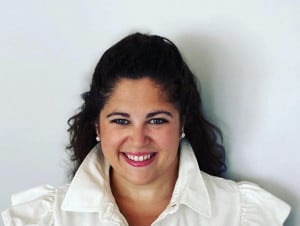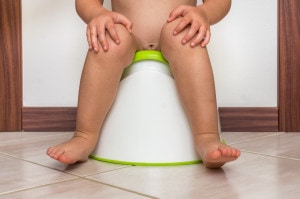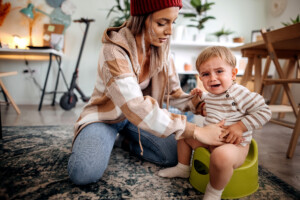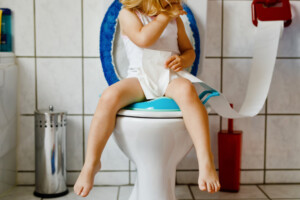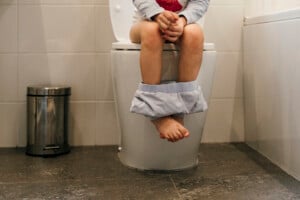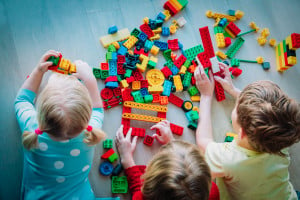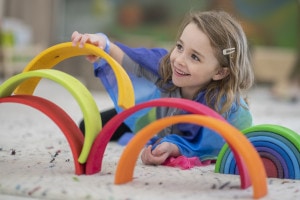Parenting is such a funny thing. You start off knowing hardly anything and learning it all. Then, just when you think you have things figured out, you get hit with a new page of parenting you didn’t know existed. Potty training is a classic example of a parenting duty we know is inevitable, yet we are never prepared when it arrives. The beauty of parenting in the twenty-first century is that we have so many resources at our fingertips to help us through these obstacles. But how do you know what is true? Which strategies are successful? What exactly will appeal to your toddler?
As an Early Childhood Developmental Specialist, I work hand in hand with families on all things parenting. Most of my time, though, I am helping families navigate the waters of potty training. I create individualized plans or host workshops to help parents feel secure and be successful all at the same time. Potty training seems to be one of the most daunting tasks to a parent, mostly because teaching a new skill to a “threenager” isn’t simple. But also because many myths seem to deter us as parents and add fear to an already arduous task.
5 Myths About Potty Training
Today, I will debunk the top five myths about potty training. I hope to help ease your fear, help you gain some confidence, and maybe learn something in the process.
1. Boys are Much Harder to Potty Train than Girls
I often wonder where this tall tale came from in the world of parenthood. It is a myth that parents constantly repeat to me as truth before they even try to potty train their son. The truth is, it is simply not the case. It has never been proven harder to potty train a boy, nor, in my experience, is it accurate. It can be said that potty training your son could lead to more prep and action than when potty training a girl, but making it harder . . . not so much.
Things to consider are making sure all liquids are “aimed” correctly in the potty. Also, you’ll need to decide as a family if you want to teach your son to sit or stand while peeing. I call these the “potty prep” tasks to figure out before introducing potty training. Sure, it adds two more tasks to this process. But if done ahead of time, it makes the training process merely the same between boys and girls.
2. Start Early (younger than two years old), and Your Child Will Learn On Their Own
There is the thought from parents that if they place their child on the potty, the child will just figure it out. So many parents run and put their babies on the potty whenever they start to pee or poop. They hope that the child will associate these bodily functions with the potty. This thought stems from other cultures that believe this is how to successfully potty train your child, and the myth has found its way here in the U.S.1
Some associations may form, but generally, children need to understand their urges cognitively and physically first. Then they’ll need to develop the desire to go to the bathroom in the toilet and not in their pants. These skills usually develop around 18 months old (or older), giving children the awareness, sense of autonomy, and competence to succeed in potty training.
3. Your Child Should Be Potty Trained By Age X
Potty training has this common misconception that it is a skill learned by a certain age. Potty training is a developmental milestone, not an age-appropriate action. This means that, just like walking, talking, and reading, it is a skill that a child needs to develop and learn. Children develop at different times and in many different ways. The key to ensuring they are developmentally ready to be potty trained is to help foster self-care, independent skills, and body awareness. Then, they will be developmentally ready to be trained with no association with their age.
4. Pick a Popular Method to Train and It Will Work
Oh, how great it would be if it were just this simple. There are many methods out there to potty train your little one. Some have become very popular, with promising results in less than three days. As discussed above, potty training is a developmental milestone, not just something learned. When a parent tries an unsuccessful method, I often hear they must have done it wrong. What if you did it perfectly, but it isn’t the right fit for your child? This is usually the case. Not all children learn to walk, talk, eat, or sleep the same. So why should learning how to use the potty be any different? Working with your child, understanding what motivates them and makes them feel secure, and creating your own “Potty Plan” is a fast way to see success and results.
5. It is Just a Matter of Discipline
This myth can be the most troublesome. Potty training can quickly become a power struggle, leaving both parents and children feeling defeated and hopeless. Parents sometimes lie to their children about the store running out of diapers or offer bribes to use the potty. Others may find themselves withholding toys or threatening some form of discipline if the child isn’t successful on the potty. This may seem extreme. But if you are at your wit’s end and feel your child purposely has accidents, you may find yourself resorting to this type of discipline. Try to keep the power out of potty training and make the process as autonomous as possible for your child. This will help reduce the risk of anxiety, fear, and other issues that create a power-struggle environment.
Potty training doesn’t have to be such a scary task in parenthood. It can be exciting! You will finally ditch the diapers and have a more independent child. This will allow you to do new and exciting things (like swimming in the adult pool at the swim club) without worrying about a soggy swim diaper. The hard part is getting to that day.
These myths can make us parents lose confidence that it can happen, especially if we have tried with little success. Stay confident, return to the basics, and tailor your training to your child and family dynamic. After all, it is them that you are doing this for. So why not make it appealing to them from the beginning? Who knows, you may even find that it was easier than you thought.


